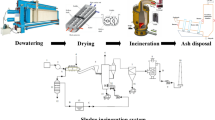Abstract
In China, over 1.43×107 tons of dewatered sewage sludge, with 80% water content, were generated from wastewater treatment plants in 2007. About 60% of the COD removed during the wastewater treatment process becomes concentrated as sludge. Traditional disposal methods used by municipal solid waste treatment facilities, such as landfills, composting, or incineration, are unsuitable for sludge disposal because of its high water content. Disposal of sludge has therefore become a major focus of current environmental protection policies. The present status of sludge treatment and disposal methodology is introduced in this paper. Decreasing the energy consumption of sludge dewatering from 80% to 50% has been a key issue for safe and economic sludge disposal. In an analysis of sludge water distribution, thermal drying and hydrothermal conditioning processes are compared. Although thermal drying could result in an almost dry sludge, the energy consumption needed for this process is extremely high. In comparison, hydrothermal technology could achieve dewatered sewage sludge with a 50%–60% water content, which is suitable for composting, incineration, or landfill. The energy consumption of hydrothermal technology is lower than that required for thermal drying.
Similar content being viewed by others
References
State EPA. China Environment Yearbook. Beijing: China Environmental Science Press, 2008, 630–631 (in Chinese)
Zhu S Q, Zhang S F, Chen H, Zhang C, Wang G H, Sun X. The plan for Shanghai slurry disposal and treatment project. Shanghai Construction Science and Technology, 2005, 4: 10–12 (in Chinese)
Yin X, Han P F, Lu X P, Wang Y R. A review on the dewaterability of bio-sludge and ultrasound pretreatment. Ultrasonics Sonochemistry, 2004, 11: 337–348
Koening A, Kay J N, Wan I M. Physical properties of dewatered wastewater sludge for landfilling. Water Science and Technology, 1996, 34(3–4): 533–540
Chan G Y S, Chu L M, Wong M H. Effects of leachate recirculation on biogas production from landfill co-disposal of municipal solid waste, sewage sludge and marine sediment. Environmental Pollution, 2002, 118: 393–399
Zhao L J, Dai S G, Gu X H. Progress on the application of the sludge landfill technology. China Water & Wastewater, 2004, 20(4): 27–30 (in Chinese)
Yang Y, Zhang H. Modifiers and engineering application in Shanghai sewage sludge landfill. Environmental Sanitation Engineering, 2008, 16(5): 43–46 (in Chinese)
Lei X L, Ye F J. Selection of sludge treatment and disposal scheme in municipal sewage treatment plant in Chongqing. China Water & Wastewater, 2008, 24(24): 9–12 (in Chinese)
Zhu W, Ji S J, Li L. Field experiment on solidification/stabilization of sludge. Environmental Science & Technology, 2009, 32(5): 131–137 (in Chinese)
Gao D, Zheng G D, Chen T B. Inactivation of heavy metals in sewage sludge by composting treatment. China Water & Wastewater, 2007, 23(4): 7–10 (in Chinese)
Zheng Y Q, Chen T B, Gao D, Zheng G D, Luo W. Influence of adding pig manure on urban sludge composting. China Water & Wastewater, 2006, 22(9): 105–108 (in Chinese)
Erdincler A, Vesilind P A. Effect of sludge cell disruption on compactibility of biological sludges. Water Science and Technology, 2000, 42(9): 119–126
Judith B, Carberry, Andrew J. Sludge Characteristics and Behavior. Boston: Martinus Nijhoff Publishers, 1983
Heukelekian H, Weisburg E. Bound Water and activated sludge bulking. Sewage and Industrial Wastes, 1956, 28: 558–574
Kopp J, Dichtl N. Prediction of full-scale dewatering results by determining the water distribution of sewage sludges. Water Science and Technology, 2000, 42(9): 141–149
Brooks R B. Heat treatment of activated sludge. Water Pollution Control, 1968, 67: 592–601
Lee D J, Hsu Y H. Measurement of bound water in sludges: A comparative study. Water Environment Research, 1995, 67(3): 310–317
Chu C P, Lee D J. Moisture distribution in sludge: Effects of polymer conditioning. Environment Engineering, 1999, 125(4):340–345
Lin J G, Chang C N, Chang S C. Enhancement of anaerobic digestion of waste activated sludge by alkaline solubilization. Bioresource Technology, 1997, 62: 85–90
Zhang G M, Zhang P Y, Yang J M. Ultrasonic reduction of excess sludge from the activated sludge system. Journal of hazardous materials, 2007, 145(3): 515–519
Vlyssides A G, Karlis P K. Thermal-alkaline solubilization of waste activated sludge as a pre-treatment stage for anaerobic digestion. Bioresource Technology, 2004, 91: 201–206
Xu Z. Commissioning of sludge disposal system of Shanghai Shidongkou municipal wastewater treatment plant. ChinaWater and Wastewater, 2005, 21(12): 98–99 (in Chinese)
Lv X R. Comission of sewage sludge dryness and incineration. Industrial Boiler, 2008, 6: 49–53 (in Chinese)
Neyens E, Baeyens J. A review of thermal sludge pre-treatment processes to improve dewaterability. Journal of Hazardous Materials, 2003, 98(1–3): 51–67
Keep U, Machenbach I, Weisz N. Enhanced stabilisation of sewage sludge through thermal hydrolysis three years of experience with full scale plant. Water Science and Technology, 2000, 42(9): 89–96
Xun R, Wang W, Qiao W. Water distribution and dewatering performance of the hydrothermal conditioned sludge. Environmental Science, 2009, 30(3): 851–856 (in Chinese)
Xia Z, Wang W, Wang Z J. Study on pilot experiment of low-pressure oxidation (LPO) of municipal sewage sludge. Journal of Harbin University of Commerce (Natural Sciences Edition), 2005, 21(2): 153–156 (in Chinese)
Author information
Authors and Affiliations
Corresponding author
Rights and permissions
About this article
Cite this article
Wang, W., Luo, Y. & Qiao, W. Possible solutions for sludge dewatering in China. Front. Environ. Sci. Eng. China 4, 102–107 (2010). https://doi.org/10.1007/s11783-010-0001-z
Received:
Accepted:
Published:
Issue Date:
DOI: https://doi.org/10.1007/s11783-010-0001-z




